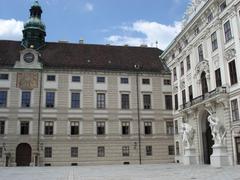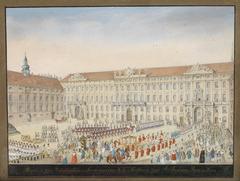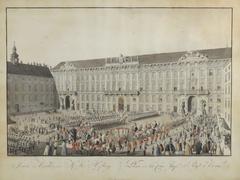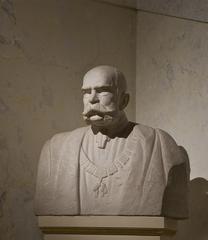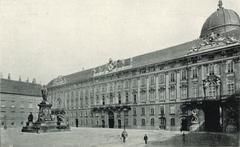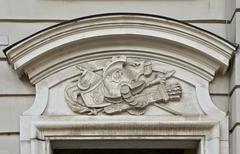
Reichskanzleitrakt Vienna: Visiting Hours, Tickets and Historical Sites Guide
Date: 14/06/2025
Introduction
The Reichskanzleitrakt, or Imperial Chancellery Wing, is a cornerstone of Vienna’s Hofburg Palace complex, embodying centuries of imperial history, political power, and Baroque architectural splendor. Originally constructed in the early 18th century under Emperor Charles VI, this iconic wing served as the administrative heart of the Holy Roman Empire and later the Austrian Empire, while its striking façade and sumptuous interiors reflect the grandeur of the Habsburg dynasty. Today, the Reichskanzleitrakt welcomes visitors eager to explore its historic apartments, learn about the lives of emperors and empresses, and experience Vienna’s rich cultural heritage. This comprehensive guide details the history, architecture, visitor information, ticketing, accessibility, guided tours, and practical tips for making the most of your visit to this remarkable site.
For the latest updates and official visitor information, see the Hofburg Palace Official Website, Sisi Museum, Vienna Tourism, and Burghauptmannschaft Österreich.
Table of Contents
- Introduction
- Historical Overview
- Key Architectural Features
- Visiting Information
- Nearby Attractions
- Frequently Asked Questions (FAQ)
- Visual Media and Suggested Resources
- Summary and Travel Tips
- References
Historical Overview
Medieval Origins and Habsburg Era
The Hofburg Palace began as a medieval fortress in the 13th century, serving as the residence of the Dukes of Austria. Over time, it was transformed and expanded by successive Habsburg rulers into a sprawling imperial complex. The Reichskanzleitrakt was conceived during the Habsburg era as Vienna became the administrative and ceremonial center of the Holy Roman Empire. It was here that the Imperial Vice-Chancellor and the Aulic Council conducted the empire’s most important political and judicial affairs.
Baroque Expansion and Architecture
Construction of the Reichskanzleitrakt commenced in the early 18th century. The initial plans by Johann Lukas von Hildebrandt were refined and completed by Joseph Emanuel Fischer von Erlach, culminating in 1730 with the creation of a monumental Baroque façade. The wing’s design features symmetrical pilasters, ornate window frames, a balustraded attic, and symbolic Herakles statues flanking the entrance—emblems of imperial power and governance (Burghauptmannschaft Österreich).
Political and Administrative Role
The Reichskanzleitrakt became the nerve center of imperial administration, housing the offices of the Imperial Vice-Chancellor and the Aulic Council. Even after the dissolution of the Holy Roman Empire in 1806, the wing retained its political significance, serving as a residence for Emperor Franz Joseph I and occasionally for other notable figures like Napoleon and the Duke of Reichstadt.
19th–20th Century Transformations
The 19th century saw significant expansion of the Hofburg complex, including the addition of museums and the reconfiguration of the Reichskanzleitrakt for ceremonial and residential purposes. The wing witnessed key historical events, such as Archduke Franz Ferdinand’s Oath of Renunciation in 1900. With the fall of the Habsburg monarchy in 1918, the palace adapted to new roles, including hosting the offices of the Austrian Federal President.
Key Architectural Features
The Reichskanzleitrakt’s Baroque façade, facing the Innerer Burghof, is a highlight of Vienna’s architectural landscape, blending harmoniously with the adjacent Leopoldinischer Trakt and Amalienburg. Inside, visitors encounter grand staircases, high-ceilinged halls, and the historic Franz Joseph Apartments, all adorned with elaborate stucco, gilded details, and period furnishings. The Sisi Museum within the wing provides a window into the personal lives of the imperial family (Sisi Museum Hofburg). Monumental Herakles statues at Schauflergasse symbolize the strength and duty of imperial rule (GeschichteWiki Wien).
Visiting Information
Location and Access
The Reichskanzleitrakt is centrally located within the Hofburg Palace complex in Vienna’s Innere Stadt. The main entrance at Michaelerplatz is well-marked, and the site is easily accessible via Vienna’s efficient public transportation:
- U-Bahn: Herrengasse (U3), Stephansplatz (U1, U3)
- Tram/Bus: Stops near Michaelerplatz and Burgring (Vienna Tourist Board)
- Address: Schauflergasse 5 / Innerer Burghof, 1010 Vienna, Austria
Visiting Hours
- Standard Opening: Daily, 9:00 AM to 5:30 PM (last admission at 4:30 PM)
- Seasonal Variations: Hours may change for holidays or special events. Always confirm current times on the official Sisi Museum website.
Tickets and Admission
- Standard Adult Ticket: €15–€20, typically covers Imperial Apartments, Sisi Museum, and Silver Collection
- Discounts: Available for students, seniors, children, and families
- Combination Tickets: Offer access to multiple Hofburg attractions
- Purchase: Online in advance or at the museum entrance; advance booking is recommended during peak seasons (Sisi Museum Hofburg)
Facilities and Accessibility
- Wheelchair Access: Ramps, elevators, and accessible restrooms provided
- Assistance: Staff available for visitors with special needs; contact ahead for tailored support
- Family-Friendly: Baby-changing facilities, stroller access, group/family tickets
- Amenities: Cloakrooms, lockers, tactile maps, and inductive listening systems for hearing-impaired visitors
Guided Tours and Audio Guides
- Guided Tours: Available in multiple languages, providing detailed historical and architectural context; booking in advance is recommended
- Audio Guides: Included with admission or available for a small fee; offer in-depth commentary for self-guided exploration (Vienna Tourist Board)
Visitor Amenities and Tips
- Restrooms: Modern facilities on-site
- Cafés: Café Hofburg and other nearby venues serve Viennese cuisine and pastries
- Gift Shops: Souvenirs, books, and replicas related to Habsburg history
- Photography: Non-flash photography allowed in public areas; restrictions apply in museum rooms—follow staff instructions
- Security: Bag checks and security screening in place; large bags not permitted
Nearby Attractions
The Reichskanzleitrakt’s central location makes it ideal for exploring Vienna’s historic sites:
- Spanish Riding School: Classical dressage with Lipizzaner horses
- Albertina Museum: Renowned for art collections and staterooms
- Imperial Treasury: Crown jewels and regalia
- Austrian National Library: Baroque masterpiece with historic collections
- St. Stephen’s Cathedral: Vienna’s iconic Gothic landmark
- Kunsthistorisches Museum: World-class art museum
- Volksgarten & Burggarten: Scenic public gardens
(Vienna Tourist Board, The Tour Guy)
Frequently Asked Questions (FAQ)
Q: What are the Reichskanzleitrakt’s visiting hours?
A: Generally open daily from 9:00 AM to 5:30 PM, with last entry at 4:30 PM. Confirm on the official website for seasonal changes.
Q: How can I purchase tickets?
A: Online via the Hofburg Palace site or at the entrance. Advance purchase is advised during busy periods.
Q: Is the Reichskanzleitrakt accessible for visitors with disabilities?
A: Yes, with ramps, elevators, and accessible restrooms. Contact staff for additional assistance if needed.
Q: Are guided tours available?
A: Yes, in multiple languages, with audio guides also available for self-guided visits.
Q: Can I photograph inside?
A: Non-flash photography is allowed in public spaces, but restrictions apply in museum rooms.
Q: What is the best time to visit?
A: Early mornings or late afternoons, especially outside peak tourist periods (April–October, December).
Visual Media and Suggested Resources
- High-resolution images of the Reichskanzleitrakt’s Baroque façade, Herakles statues, and imperial interiors (use alt text such as “Reichskanzleitrakt Vienna façade” and “Baroque interiors of Reichskanzleitrakt”).
- Interactive maps of the Hofburg Palace for easier navigation.
- Virtual tours and multimedia guides available via the Hofburg Palace Official Website.
Summary and Travel Tips
The Reichskanzleitrakt is a linchpin of Vienna’s imperial legacy, offering visitors unparalleled insight into the city’s political, cultural, and architectural history. From its origins as the seat of imperial administration to its current role as a museum and government wing, the Reichskanzleitrakt stands as a living testament to the grandeur of the Habsburg era. Key visitor amenities, comprehensive accessibility features, and a wealth of nearby attractions make it a must-visit site in Vienna. For a seamless experience, plan ahead using official resources, purchase tickets online, and consider guided tours or audio guides such as those offered by the Audiala app.
References and External Links
- Hofburg Palace Official Website
- Sisi Museum Hofburg
- Vienna Tourism
- Burghauptmannschaft Österreich
- Vienna Tourist Board
- The Tour Guy
